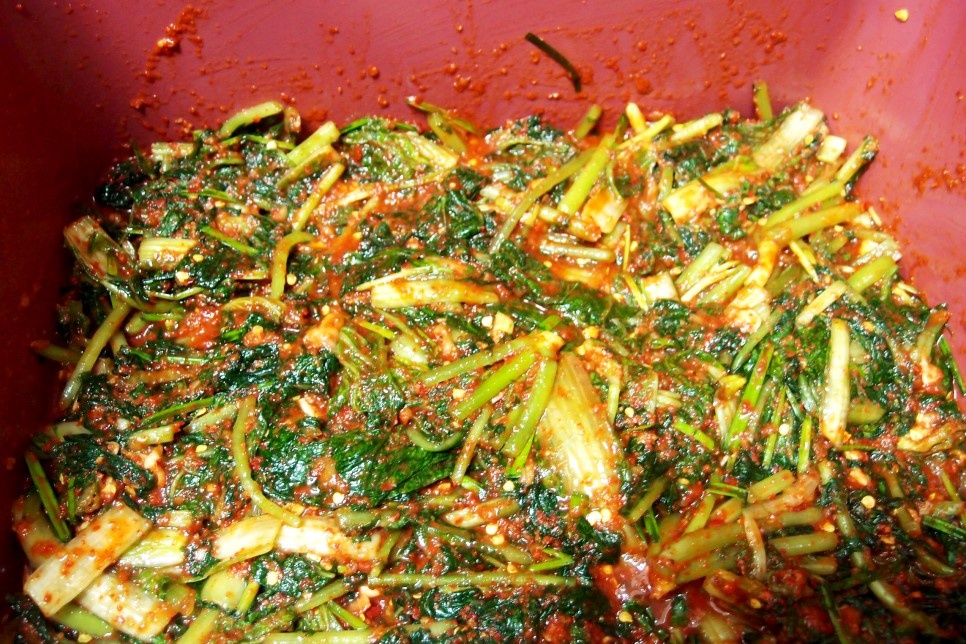Crisp and Refreshing Young Radish and Crown Daisy Kimchi
#SummerDelicacy #YoungRadishCrownDaisyKimchi #PerfectMatchForNoodlesAndRamen #CrispyTexture #CoolKimchi

Introducing a recipe for young radish and crown daisy kimchi, a perfect summer delicacy with a wonderfully crisp and refreshing taste. This kimchi features fresh young radishes and tender crown daisies as the main ingredients, enhanced with a deep flavor from our meticulously prepared broth and glutinous rice paste seasoning. It’s a perfect pairing for any noodle dish, including bibim guksu, janchi guksu, and ramen, and it’s sure to whet your appetite even on days when you don’t feel like eating!
Kimchi Ingredients- 2 bunches Crown Daisy (Eolgari)
- 1 bunch Young Radish (Yeolmu)
- 1/2 bunch Garlic Chives (optional)
- 1/2 cup Coarse Sea Salt
- 3 cups Kimchi Seasoning
Kimchi Seasoning Ingredients- 2 cups Natural Broth
- 1 cup Glutinous Rice Paste (thickly cooked)
- 2 cups Gochugaru (Korean chili powder)
- 3 Tbsp Minced Garlic
- 1 stalk Large Green Onion (chopped)
- 1 tsp Minced Ginger
- 1 cup Grated Radish
- 1/2 cup Chili Seeds (or substitute with 1/2 cup Gochugaru)
- 1/3 cup Saeujeot (fermented shrimp, finely minced)
- 1/2 cup Myeolchi Aekjeot (fermented anchovy sauce)
- 1 Tbsp Sugar
- 1/3 cup Maesil Cheong (plum extract syrup)
- 2 cups Natural Broth
- 1 cup Glutinous Rice Paste (thickly cooked)
- 2 cups Gochugaru (Korean chili powder)
- 3 Tbsp Minced Garlic
- 1 stalk Large Green Onion (chopped)
- 1 tsp Minced Ginger
- 1 cup Grated Radish
- 1/2 cup Chili Seeds (or substitute with 1/2 cup Gochugaru)
- 1/3 cup Saeujeot (fermented shrimp, finely minced)
- 1/2 cup Myeolchi Aekjeot (fermented anchovy sauce)
- 1 Tbsp Sugar
- 1/3 cup Maesil Cheong (plum extract syrup)
Cooking Instructions
Step 1
First, trim the wilted or yellow outer leaves from the crown daisy. Then, wash them thoroughly under running water, paying attention to the root area, and drain well to prepare.

Step 2
Cut the washed crown daisy into manageable pieces, about 3 segments each. Since we’ll be salting them immediately after cutting, placing them in the salting container beforehand will make the process more convenient.

Step 3
Next, prepare the young radishes. Thoroughly remove any soil or debris from the root part of the young radish. If the outer skin looks dirty, you can peel it lightly before washing them clean and setting them aside.

Step 4
Cut the young radishes into roughly 4 segments, similar to the crown daisy, and place them together in the salting container. Add the coarse sea salt (1/2 cup) and water (about 3 cups). Gently mix everything to avoid bruising the vegetables, which can cause a raw, grassy flavor. Cover the container and let it salt for about 30 minutes to 1 hour, or until the vegetables are wilted. You can gently toss them once or twice during this time.

Step 5
While the vegetables are salting, let’s start making the kimchi seasoning. First, we need to make the glutinous rice paste. Since we’ll be adding broth, it’s best to cook the paste a bit thicker than usual. Once the glutinous rice paste is ready, set it aside to cool completely.

Step 6
Now, let’s prepare the broth for the kimchi seasoning. You can make a broth using ingredients like anchovies, dried kelp, and radish. Adding a splash of Cheongju (rice wine) while boiling can help eliminate any fishy odors. Strain the broth through a sieve to remove any solids and let it cool completely.

Step 7
While the broth and glutinous rice paste are cooling, prepare the other seasoning ingredients. Chop one large green onion into bite-sized pieces.

Step 8
Add 1 cup of grated radish to the cooled glutinous rice paste. Grated radish adds a refreshing element to the kimchi and helps the seasoning bind together well.

Step 9
Next, add 2 cups of gochugaru (Korean chili powder) and 1/2 cup of chili seeds. Chili seeds contribute a refreshing and deep flavor to the kimchi, and they are also great for making water kimchi.

Step 10
Now, add 3 tablespoons of minced garlic, 1/3 cup of finely minced saeujeot (fermented shrimp), the chopped green onion, 1 teaspoon of minced ginger, 1/2 cup of myeolchi aekjeot (fermented anchovy sauce), and 1/3 cup of maesil cheong (plum extract syrup).

Step 11
Finally, add 1 tablespoon of sugar and mix everything thoroughly until well combined. This kimchi seasoning can be used immediately, but it’s even better if you let it rest in the refrigerator for a while to allow the flavors to meld and deepen.

Step 12
Check the salted crown daisy and young radish. Make sure they are sufficiently wilted. Taste them: if they are too salty, rinse them lightly under cold water and drain; if the saltiness is just right, simply squeeze out the excess water without rinsing.

Step 13
Add the prepared kimchi seasoning to the drained young radish and crown daisy. Also, add the chopped garlic chives (1/2 bunch, if using – you can omit this if you don’t have them).

Step 14
Now, gently mix everything together, ensuring not to mash the vegetables. The key is to mix gently to maintain the crispness and prevent a raw flavor. Coat all the vegetables evenly with the seasoning. The color looks beautifully appetizing!

Step 15
Transfer the well-mixed kimchi into a container. Cover the surface with plastic wrap to minimize air exposure. Close the lid and let it ferment at room temperature for 2-3 days. Then, move it to your kimchi refrigerator and let it age for another 1-2 days at a low temperature for a perfectly chilled and delicious kimchi.

Step 16
And there you have it – perfectly fermented young radish and crown daisy kimchi! The wonderful aroma of well-fermented kimchi is already making my mouth water. Enjoy a delightful meal with this cool and crisp kimchi this summer!




